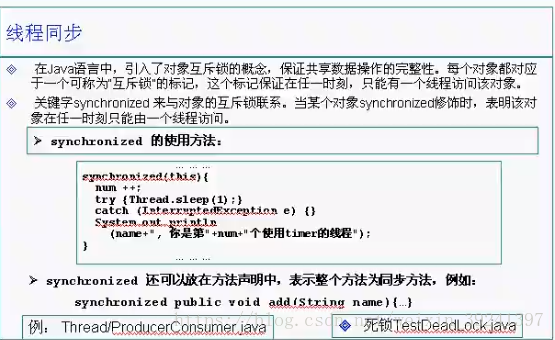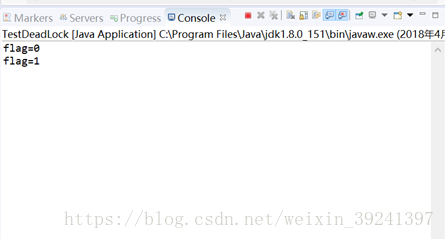
来模拟一个死锁(互相等待):
TestDeadLock.java
package com.zhj.www;
public class TestDeadLock implements Runnable {
public int flag = 1;
static Object o1 = new Object();
static Object o2 = new Object();
public void run() {
System.out.println("flag=" + flag);
if(flag ==1) {
synchronized (o1) {
try {
Thread.sleep(500);
}catch (Exception e) {
e.getStackTrace();
}
synchronized (o2) {
System.out.println("1");
}
}
}
if(flag ==0) {
synchronized (o2) {
try {
Thread.sleep(500);
}catch (Exception e) {
e.getStackTrace();
}
synchronized (o1) {
System.out.println("0");
}
}
}
}
public static void main(String[] args) {
TestDeadLock td1 = new TestDeadLock();
TestDeadLock td2 = new TestDeadLock();
td1.flag = 1;
td2.flag = 0;
Thread t1 = new Thread(td1);
Thread t2 = new Thread(td2);
t1.start();
t2.start();
}
}运行结果:

我们发现程序处于已知等待的情况下。
哲学家吃饭问题(多个线程死锁):
怎么解决?把锁的粒度加粗,不如把整个对象锁住,而不是只是锁几行。
粒度:实现数据库的产品,锁在行一级还是表一级。
面试题:
package com.zhj.www;
public class TestInterviewQuestion1 implements Runnable {
int b =100;
public synchronized void m1() {
try {
b = 1000;
Thread.sleep(5000);
System.out.println("b = "+b);
} catch (Exception e) {
e.getStackTrace();
}
}
public void m2() {
System.out.println(b);
}
public void run() {
try {
m1();
}catch (Exception e) {
e.getStackTrace();
}
}
public static void main(String[] args) throws Exception{
TestInterviewQuestion1 testInterviewQuestion1 = new TestInterviewQuestion1();
Thread thread = new Thread(testInterviewQuestion1);
thread.start();
Thread.sleep(1000);
testInterviewQuestion1.m2();
}
}运行结果:
1000
b = 1000
修改一下:
package com.zhj.www;
public class TestInterviewQuestion1 implements Runnable {
int b =100;
public synchronized void m1() {
try {
b = 1000;
Thread.sleep(5000);
System.out.println("b = "+b);
} catch (Exception e) {
e.getStackTrace();
}
}
public synchronized void m2() throws Exception {
Thread.sleep(2500);
b = 2000;
}
public void run() {
try {
m1();
}catch (Exception e) {
e.getStackTrace();
}
}
public static void main(String[] args) throws Exception{
TestInterviewQuestion1 testInterviewQuestion1 = new TestInterviewQuestion1();
Thread thread = new Thread(testInterviewQuestion1);
thread.start();
//Thread.sleep(1000);
testInterviewQuestion1.m2();
System.out.println(testInterviewQuestion1.b);
}
}对每个方法加不加锁,要考虑清楚。
互斥:某个时间段,只有一个线程进入这个方法,但不保证不进入另外一个线程。
不允许多个线程同时写,但允许多个线程读。










 本文通过一个Java示例程序模拟了死锁现象,并探讨了解决方案。此外,还介绍了一个面试题案例,演示了如何使用synchronized关键字来确保线程安全。
本文通过一个Java示例程序模拟了死锁现象,并探讨了解决方案。此外,还介绍了一个面试题案例,演示了如何使用synchronized关键字来确保线程安全。

















 被折叠的 条评论
为什么被折叠?
被折叠的 条评论
为什么被折叠?








